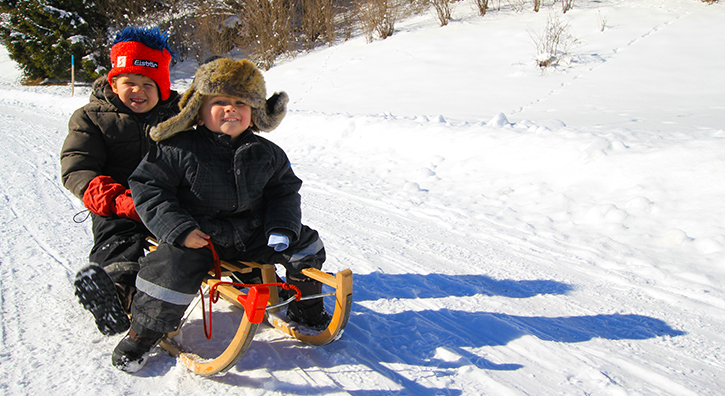0800 260 5082
Available from Monday to Friday from 9am to 7pm, and Saturday from 10am to 7pm. Closed on Sunday.
Available from Monday to Friday from 9am to 7pm, and Saturday from 10am to 7pm. Closed on Sunday.
In winter, the snow is perfect for both skiing and sledging. That’s why ski resorts are also a must-visit destination for anyone who loves sledging.
Sledging gained its International Federation in 1913 in Dresden, Germany, which later merged with the International Bobsleigh Federation. Today, the most popular type of sledge is the Davos model — a wooden frame with two runners, designed for up to two people. Riders can steer or brake by pushing their feet into the snow. Bobsleigh, which appeared much later in the 1960s, is a steerable sled with a plastic shell and a seat with a backrest. Unlike a sledge, a bob is controlled using handles on each side.
One of the main advantages of sledges and bobs is that they require less snow than skis or snowboards to glide from the top. This means they can be enjoyed both on higher slopes and at lower altitudes. If you’re after an adrenaline rush and something a little different, take your family on a sledging day trip this winter.
When sledging, it’s important to follow safety rules to protect yourself and your riding partner: control your speed and direction, overtake on either side while keeping a safe distance, follow slope markers and signs, and leave the piste quickly in case of a fall.
Feel the thrill of sledging on the slopes!

Depending on the type of slope, sledging can take place in dedicated areas – that is, on natural slopes where the weather and landscape naturally suit the activity. In this case, the sledge follows a natural downhill route from the mountain summit. From this first form comes track sledging, which takes place on a clearly marked course that can be enjoyed by all sledgers.
Finally, rail sledging – now common in hybrid attractions – is done on a purpose-built, profit-driven installation.
Bonus tip: try snowtubing, a fun variation of sledging. This thrilling activity involves sliding down a slope on an inflatable tube – pure adrenaline guaranteed!


A sledge is usually made from recycled materials such as plastic drums, old skis, scooter handlebars, or wooden slats. The safety of sledgers is ensured by a steering mechanism and a claw braking system.
Whatever the discipline, sledgers must always wear appropriate clothing and accessories. First and foremost, wearing a helmet made of fibre, carbon, and foam is essential to protect the head from impacts. The open-face helmet should include a bubble visor to maximise visibility during the ride.
In designated areas, sledgers must wear a fully functional suit along with a lead vest weighted according to regulations. The amount of weight is determined by the International Luge Federation based on the rider’s weight.
For rail sledging in particular, sledgers must protect their shoulders with a layer of leather or plastic to absorb impacts, while their hands are equipped with leather gloves and steel-tipped spikes. Finally, sledgers wear two different types of slippers depending on whether it’s training (slippers with suction cups for better grip) or racing (smooth, lightly worn slippers).

French ski resorts are offering increasingly diverse sledging options. Beyond designated areas at the base of the slopes, many sledging runs have been developed to provide a full non-ski experience for both parents and children.
Every year, Valmeinier ski resort offers tourists the chance to enjoy free sledging in a designated area.
The Val Thorens Toboggan offers a 6 km run with a 700 m vertical drop; the course starts at 3,000 m altitude and takes about 45 minutes to descend, featuring banked turns. The sledging track is open both day and night, with a price of €14 per run (free for children aged 5 to 10).
The Fantasy Luge in Super-Besse costs €9 per run, including sledge and helmet rental.
The Grand Tourmalet at Mongie Village charges €11 per person, with sledge and helmet hire included.
Wiidoogliss in La Bresse offers 2 sledging runs for €7.50 per half-day (children pay €6).
The Orrian Express at Les Orres resort, Hautes-Alpes, costs €7.50.
Speed Mountain at Les Menuires resort in Savoie is priced at €12.